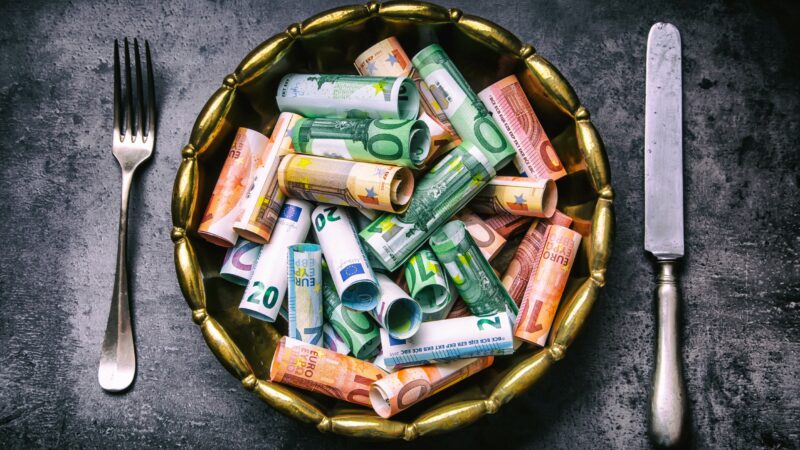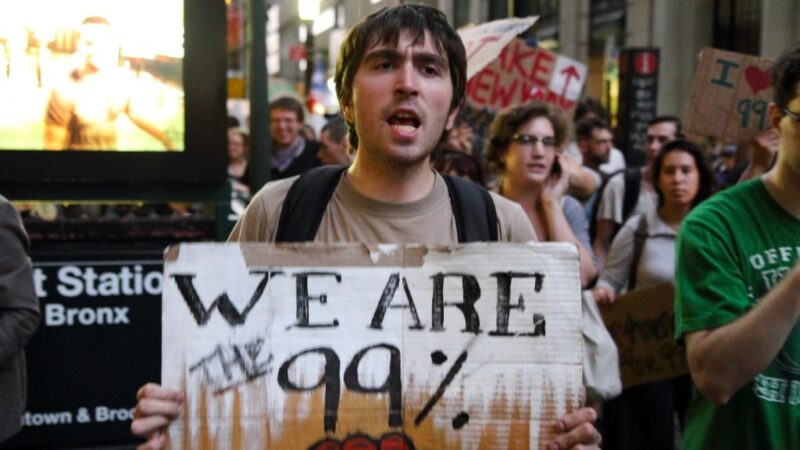 The higher the percentage of the household budget spent on food the more inflation is felt. Inflation hits the lower income brackets especially hard. (Image 123RF)
The higher the percentage of the household budget spent on food the more inflation is felt. Inflation hits the lower income brackets especially hard. (Image 123RF) Ancient Rome declined because, among other reasons, its economy was insufficiently productive. It ultimately lived on robbery; at that time, one could only become rich at the expense of others. To compensate for this, more and more money was put into circulation from the existing stock of precious metals by constantly depreciating coins—changing the alloy by adding less-valuable metals: this is precisely “inflation,” the inflation of the money supply. More and more money was needed to pay for the ever-increasing government spending on defending the borders. This eventually led the empire to collapse.
History never repeats itself exactly, but there are recurring patterns: especially where economic, but also socio-psychological laws are involved. This is the case of monetary policy.
History never repeats itself exactly, but there are recurring patterns: especially where economic, but also socio-psychological laws are involved. This is the case of monetary policy. If the money supply increases while the supply of produced goods remains constant, the prices of these goods will rise. The decline in purchasing power accelerates once people expect that things will soon get worse. Behind this process is a growing loss of confidence in the currency, the state, and politics.
From Paper Money Bubbles to Credit-Monetary Inflation
Paper money that just had to be printed led to even greater inflationary excesses. In 18th century France, for example, John Law’s money experiment ended in the bursting of a huge bubble after only a short time. A similar fate befell the “assignats” of the French revolutionary period, or the German mark in the period of hyperinflation after the First World War. More recently, since 1971 when Richard Nixon detached the dollar (and thus the entire international monetary system) from its link to gold, money has been created “out of nothing.” There is no longer a currency anchor. Paper money—banknotes—now plays only a subordinate role. Money is now “printed” electronically at the push of a button—in theoretically unlimited quantities—as pure book money in the banking system.
There is still a widespread notion that banks give out loans with funds drawn only from the savings their customers previously entrusted to them—but this is far from the truth.
There is still a widespread belief that banks give out loans with funds drawn only from the savings their customers previously entrusted to them—but this is far from the truth. Indeed, banks can also lend out additional loans through money creation. In this way, every time a bank grants a loan, new money is created by a mere accounting trick. The banks thus create new money through their lending—in accordance with the monetary policy guidelines of the central banks, which can control the total money supply “as needed.”
This works relatively well so long as the loans are used to finance profitable long-term business investments and the monetary policy reins are tight—in other words, it works when this process operates within narrow limits. But today’s world of credit money is characterized by inflationary mischief. With the disastrous intention of stimulating the economy, central banks use interest rate cuts to ensure that cheap credit money also finances projects with low returns.
This leads to a boom with mass malinvestment. As a result of the scarcity of resources caused by the expansion of the circulating money supply and the simultaneous unabated consumption—because there is no increase in savings—prices rise everywhere. Suddenly, the investments made with the cheap money then no longer pay off. The result is the familiar economic cycles—upswings and downswings—with their notorious economic and social upheavals.
Inflationary Monetary Policy as Crisis and Rescue Policy
After the financial crisis of 2008/09, however, central banks kicked it up a notch. Now they began to pump credit money into the system themselves, not to stimulate the economy but to rescue the banking system and over-indebted states and to keep the teetering Eurosystem from collapsing. To this end, the ECB bought government bonds en masse over a period of years, not directly from the issuing states—that would have been direct government financing, which is prohibited—but on the so-called secondary market, which in fact amounts to the same thing. This also happened with Fed in the USA. The banks were bought out of their sovereign debts by means of freshly printed fiat money from the central banks—with a simple accounting trick on an ECB or Fed computer.
The state—or rather the politicians—like to distribute because it wins them elections. The central banks make sure they do not run out of money.
But after the first (correct and necessary) injection of liquidity to avoid the collapse of the financial system after the crisis, the steady flow of money followed. The ECB and the Fed became a constantly bubbling spring of money to solve all problems: the euro rescue fund, the pandemic reconstruction fund, huge infrastructure programs, the ECB’s new “transmission protection instrument” to save structurally weak states from paying too much interest on their debts, and now all kinds of compensation payments to consumers to “offset” rising energy prices. All these policies drive inflation. The state, or rather the politicians, like to distribute because it wins them elections. The central banks make sure they do not run out of money.
The Unsocial Consequences: Loss of Purchasing Power, Privileging of the Financial Sector, and Growing Inequality
Inflation, however, has extremely antisocial and thus ethically relevant consequences. It does not simply mean an increase in prices. If the price of gas or oil rises because of a shortage of gas or oil, this is not inflation, but an increase in relative prices. An existing demand meets a shrinking supply, and prices go up. The problem gets solved (if it can be solved) by increasing the supply of gas and oil or by temporarily reducing consumption.
But the contribution of the war-related rise in energy prices to the current rate of inflation should not be overestimated. In reality, this began to rise significantly in both Europe and the USA long before the war and the energy shortage. “Inflation” is not simply inflation, but expansion of the money supply not matched by a corresponding increase in the supply of goods. Inflation is excess money. Rising prices are a consequence of inflation.
Inflation distorts the entire social fabric. It causes a bottom-up redistribution. From a moral philosophical point of view, this is a tremendous injustice.
Prices do not rise immediately and everywhere to the same extent, but rather the “Cantillon effect” occurs. First, the newly created money flows into those sectors of the economy that are closest to the sources of money creation, for example, into the financial sector. Its players still receive the new money with undiminished purchasing power. Only then does it “eat its way” through every sector of the economy.
The higher money supply, however, initially encounters an unchanged supply of raw materials and production goods. These become scarcer and more expensive as a result. Finally (but then with greater strength), the “normal” prices of consumer goods climb. This hits all consumers, but it hits the lowest income groups hardest of all. These groups are far removed from the sources of money creation, do not own any real estate or stock portfolios, and therefore do not benefit from price increases: ordinary wage earners and consumers, whose real incomes and prosperity thus shrink painfully.
Distortion of the Social Fabric and the Structure of Production: The “Zombification” of the Economy
The fact that real estate and stock owners are getting richer and that players in the ever-expanding financial sector are earning enormous incomes (thus increasing social inequality) is not a consequence of “antisocial” capitalism, but of the central banks’ misguided policy of constantly expanding the money supply and the debt economy of the nations that this makes possible. Inflation distorts the entire social fabric. It causes a bottom-up redistribution. From a moral-philosophical point of view, this is a tremendous injustice.
Moreover, inflation upsets the production structure of the economy. Money is not, as economists say, “neutral”; it does not simply raise the “price level” uniformly everywhere, just as water in a swimming pool rises uniformly everywhere. Rather, it affects the relative prices of goods used in production, thereby distorting the fabric of the economy. The result is mass entrepreneurial miscalculation and a corresponding misallocation of scarce resources. All this comes at the expense of general prosperity.
In other words, low interest rates and cheap money is therefore multi-level fraud against the citizens. Moreover, it is unsocial.
Furthermore, the inflationary policy of cheap money leads to the so-called zombification of the economy. A company must at least be able to service the loans it has taken out with the profit it generates, otherwise it will go bankrupt. If the interest rate is low or zero, however, there is no need to increase productivity and thus the profitability of the company to any great extent. This not only affects the level of innovation, but also real wages.
In other words, low interest rates and cheap money is therefore multi-level fraud against the citizens. Moreover, it is unsocial: the purchasing power of money decreases, wages do not increase, and an entire society becomes less innovative, thus causing prosperity to grow more slowly, if not decline in the longer term.
The Remedy: A Shortage of Money and Recession
Since the poison of inflation is monetary in nature, it can only be contained by monetary measures: specifically, by raising interest rates and making money scarcer. This necessarily leads to recession, since there will be bankruptcies due to rising interest costs—possibly on a massive scale. This is what politicians are afraid of, even though a recession is an inevitable healing process. If it is prevented by easing monetary policy (this is referred to as a “soft landing”) the unsolved problems and structural distortions are postponed. They then return, however, with a vengeance in a later phase and lead to an even greater crisis.
Recessions must be socially cushioned, especially because of the short-term rise in unemployment, not with a watering can, but by providing targeted aid to those who really need it.
Only a recession can stop and reverse this process. Recessions must be socially cushioned, especially because of the short-term rise in unemployment, not with a watering can, but by providing targeted aid to those who really need it. Unprofitable companies, however, must be allowed to go bankrupt, which is a macroeconomic gain in the long run.
Even though they carry high social and political risks because of the social upheavals, recessions are economic beacons of hope. For bankruptcy does not mean the destruction of capital, but rather the punishment of incompetent entrepreneurs and managers, or those who have become sluggish or misguided because of cheap money. Factories, machines, and know-how are then sold cheaply and end up in the hands of those who can once again operate profitably in the incipient upswing resulting from the cheap purchase—which becomes necessary because of rising interest rates.
The Remedy Recession Works in the Service of the Common Good
In such a situation, the task of the churches and other socially committed institutions is not to denounce layoffs and unemployment as a “scandal” or “unjust” or even (in line with the unions) to try to prevent them. That would mean acting against the common good. For the common good, which also includes the good of future generations, demands a radical recovery of the economic fabric. In such a situation, the task is to confront people with the truth, to give hope and to stand by those who, despite the state’s safety nets, remain on the street, so to speak.
But if politicians now try to put the problem on the back burner once again, the crash will be that much the greater and more painful. Such a policy would be contrary to the common good. Our economy is, however, dependent on low interest rates as if it were a drug, and so are the over-indebted countries. If the drug were taken away from them, national bankruptcies or debt cuts and currency reforms would be unavoidable, but also salutary. But it will be hard to find a politician who is willing to tell his voters the truth. And so, people will probably continue to bury their heads in the sand. Ancient Rome sends its regards!
This article originally appeared under the title “Wir brauchen eine Rezession!” in the magazine Der Pragmaticus, December 2022, pp. 60–64. Here it is online.
Translation from German by Thomas and Kira Howes
Share on
- Banking and credit
- Blog
- Business Cycle Theory
- Central Banks
- Common Good
- Economic ethics
- Energy
- Entrepreneurship
- Featured Content
- Inequality
- Inflation
- Innovation
- Interest
- Interest rate policy
- Low interest rate policy
- Martin Rhonheimer
- Monetary policy
- Poverty
- Prosperity
- Public debt
- Redistribution
- Social justice
- State, Government and Politics
- Work



